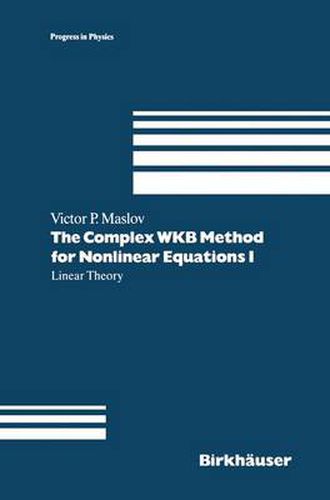Readings Newsletter
Become a Readings Member to make your shopping experience even easier.
Sign in or sign up for free!
You’re not far away from qualifying for FREE standard shipping within Australia
You’ve qualified for FREE standard shipping within Australia
The cart is loading…






This title is printed to order. This book may have been self-published. If so, we cannot guarantee the quality of the content. In the main most books will have gone through the editing process however some may not. We therefore suggest that you be aware of this before ordering this book. If in doubt check either the author or publisher’s details as we are unable to accept any returns unless they are faulty. Please contact us if you have any questions.
This book deals with asymptotic solutions of linear and nonlinear equa- tions which decay as h —+ 0 outside a neighborhood of certain points, curves and surfaces. Such solutions are almost everywhere well approximated by the functions cp(x) exp{iS(x)/h}, x E 1R3, where S(x) is complex, and ImS(x) ~ o. When the phase S(x) is real (ImS(x) = 0), the method for obtaining asymp- totics of this type is known in quantum mechanics as the WKB-method. We preserve this terminology in the case ImS(x) ~ 0 and develop the method for a wide class of problems in mathematical physics. Asymptotics of this type were constructed recently for many linear prob- lems of mathematical physics; certain specific formulas were obtained by differ- ent methods (V. M. Babich [5 -7], V. P. Lazutkin [76], A. A. Sokolov, 1. M. Ter- nov [113], J. Schwinger [107, 108], E. J. Heller [53], G. A. Hagedorn [50, 51], V. N. Bayer, V. M. Katkov [21], N. A. Chernikov [35] and others). However, a general (Hamiltonian) formalism for obtaining asymptotics of this type is clearly required; this state of affairs is expressed both in recent mathematical and physical literature. For example, the editors of the collected volume [106] write in its preface: One can hope that in the near future a computational pro- cedure for fields with complex phase, similar to the usual one for fields with real phase, will be developed.
$9.00 standard shipping within Australia
FREE standard shipping within Australia for orders over $100.00
Express & International shipping calculated at checkout
Stock availability can be subject to change without notice. We recommend calling the shop or contacting our online team to check availability of low stock items. Please see our Shopping Online page for more details.
This title is printed to order. This book may have been self-published. If so, we cannot guarantee the quality of the content. In the main most books will have gone through the editing process however some may not. We therefore suggest that you be aware of this before ordering this book. If in doubt check either the author or publisher’s details as we are unable to accept any returns unless they are faulty. Please contact us if you have any questions.
This book deals with asymptotic solutions of linear and nonlinear equa- tions which decay as h —+ 0 outside a neighborhood of certain points, curves and surfaces. Such solutions are almost everywhere well approximated by the functions cp(x) exp{iS(x)/h}, x E 1R3, where S(x) is complex, and ImS(x) ~ o. When the phase S(x) is real (ImS(x) = 0), the method for obtaining asymp- totics of this type is known in quantum mechanics as the WKB-method. We preserve this terminology in the case ImS(x) ~ 0 and develop the method for a wide class of problems in mathematical physics. Asymptotics of this type were constructed recently for many linear prob- lems of mathematical physics; certain specific formulas were obtained by differ- ent methods (V. M. Babich [5 -7], V. P. Lazutkin [76], A. A. Sokolov, 1. M. Ter- nov [113], J. Schwinger [107, 108], E. J. Heller [53], G. A. Hagedorn [50, 51], V. N. Bayer, V. M. Katkov [21], N. A. Chernikov [35] and others). However, a general (Hamiltonian) formalism for obtaining asymptotics of this type is clearly required; this state of affairs is expressed both in recent mathematical and physical literature. For example, the editors of the collected volume [106] write in its preface: One can hope that in the near future a computational pro- cedure for fields with complex phase, similar to the usual one for fields with real phase, will be developed.